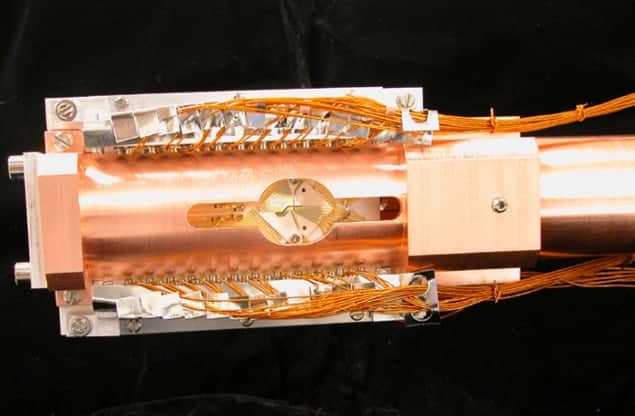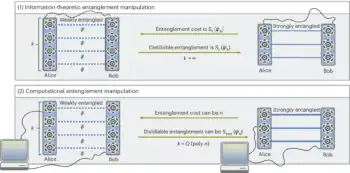
Quantum entanglement has been created and measured between pairs of two different kinds of nuclei for the first time. Carried out by two independent research groups, the work is a key step towards the creation of ion-based quantum computers, in which different nuclei perform different functions. One of the groups is based at the University of Oxford in the UK and the other at the National Institute of Standards and Technology (NIST) in Boulder, Colorado.
Information in a quantum computer is stored and transmitted in quantum bits (qubits), which can be entities such as photons or ions. Qubits will quickly lose their quantum nature when in contact with the outside world, which is a challenge for those designing quantum computers. Individual qubits must interact with each other for a quantum calculation to proceed, and so cannot be completely isolated from the outside world.
Information transfer
One way round this issue is to use different types of qubits to perform different functions within a quantum computer. Qubits that are easy to isolate, for example, could store information, whereas qubits that interact in well-defined ways would process the data. For such hybrid schemes to work, however, quantum information must be transferred from one type of qubit to another, which requires the different types of qubit to be quantum-mechanically entangled.
Entanglement allows two or more particles to have a much closer relationship than is permitted by classical physics, no matter how far apart they may be. The states of entangled particles are inextricably linked, such that any change made to one particle instantly influences the state of the other.
Ions trapped in a tiny vacuum chamber are one way of creating such a hybrid quantum computer. This is because some ions will interact with each other (and their surroundings), while others can be held in relative isolation. Now, two independent teams have shown that pairs of different types of ion can be entangled.
Chris Ballance and colleagues at Oxford used two different isotopes of the same element as their ions: calcium-40 and calcium-43. Meanwhile at NIST, Ting Rei Tan, Dave Wineland and the team used beryllium-9 and magnesium-25 as their ions. Laser light (along with microwaves at NIST) was used to create a “ferromagnetic” interaction between the spins of a pair of two different ions separated by a few microns. This interaction means that if the spin of one ion points “up”, the spin of the other ion will tend to point in the same direction.
Close relationship
The teams then needed to verify that the two ions are entangled in this ferromagnetic state.
Both teams verified entanglement using a Bell inequality, which involves measuring the correlations between the spins of the two ions. The first ion is put into a quantum superposition of being in both the spin-up and spin-down states. Then the ferromagnetic interaction is switched on. The result is a pair of ions that are in a quantum superposition of being both spin-up and both spin-down.
A measurement is made on the first ion – forcing it into either a spin-up or spin-down state. The outcome of this measurement is random; but if the ions are entangled, the result will have a measureable influence on a subsequent measurement of the spin state of the second ion.
Some correlation between the spin states is expected from classical physics, and Bell’s inequality puts an upper limit on its value. If the correlations are any stronger, then the ions must be entangled quantum-mechanically. In this case, the upper limit for classical correlations is 2, and the NIST team measured a value of 2.70, which is a whopping 40 standard deviations from the classical value. The Oxford team achieved a more modest 2.228, which is still an impressive 15 standard deviations away from the classical outcome.
Similar but different
Ballance told physicsworld.com that the calcium-43 ion is “the best qubit around”, with single-ion quantum memories able to store quantum information for about one minute. Calcium-40, in contrast, is better suited for interacting with photons of light, which could be used to transmit quantum information within quantum computers and also from one quantum computer to another. Ballance adds that a benefit of using ions that are isotopes of the same element is that the isotopes are similar enough to be handled the same way in the ion trap.
“Each ion species is unique,” adds Tan. “Certain ones are better suited for certain tasks such as memory storage, while others are more suited to provide interconnects for data transfer between remote systems.”
The research is described in two separate papers in Nature.



